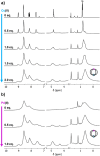Single-Step Synthesis of a Heterometallic [Cu2PdL4]2+ Hybrid Metal-Organic Coordination Cage
- PMID: 40167504
- PMCID: PMC12124452
- DOI: 10.1002/anie.202506064
Single-Step Synthesis of a Heterometallic [Cu2PdL4]2+ Hybrid Metal-Organic Coordination Cage
Abstract
Traditional methods of assembling low-symmetry heterometallic cage architectures are limited to stepwise construction and combinations of inert and labile metal ions, affording complex, anisotropic cage structures by sacrificing synthetic ease. Herein, a heterometallic [Cu2PdL4]2+ lantern-type cage has been assembled in a single self-assembly step through the use of a heteroditopic ligand with two different metal-binding groups. The resultant cage complex is a fusion of two common lantern-type cage motifs-carboxylate-based metal-organic Cu4L4 cages and pyridyl-based Pd2L4 coordination cages. Evidence for heterometallic cage formation in solution was provided by 1H and diffusion-ordered NMR spectroscopy and electrospray ionization mass spectrometry (ESIMS) data, whereas circular dichroism (CD) spectra confirmed the helical nature of the assembly. The heterometallic cage was then exploited in binding heterotopic guests. It is envisioned that the simple design strategy presented herein will ease the assembly of other structurally complex, low-symmetry cage architectures.
Keywords: Cages; Copper(II); Heterometallic complexes; Low‐symmetry; Palladium(II).
© 2025 The Author(s). Angewandte Chemie International Edition published by Wiley‐VCH GmbH.
Conflict of interest statement
The authors declare no conflict of interest.
Figures



Similar articles
-
Stepwise assembly of mixed-metal coordination cages containing both kinetically inert and kinetically labile metal ions: introduction of metal-centred redox and photophysical activity at specific sites.Dalton Trans. 2015 Nov 7;44(41):17939-49. doi: 10.1039/c5dt02957k. Epub 2015 Sep 25. Dalton Trans. 2015. PMID: 26406288
-
A Reduced-Symmetry Heterobimetallic [PdPtL4 ]4+ Cage: Assembly, Guest Binding, and Stimulus-Induced Switching.Angew Chem Int Ed Engl. 2020 Jun 26;59(27):11101-11107. doi: 10.1002/anie.202003220. Epub 2020 Apr 30. Angew Chem Int Ed Engl. 2020. PMID: 32220036
-
Heterometallic-Organic Cages with Customized Cavities: Constructed by Bottom-Up Step-Wise Coordination-Driven Self-Assembly.Chemistry. 2024 Nov 12;30(63):e202402499. doi: 10.1002/chem.202402499. Epub 2024 Oct 16. Chemistry. 2024. PMID: 39152769
-
Conjoined and non-conjoined coordination cages with palladium(II) vertices: structural diversity, solution dynamics, and intermolecular interactions.Chem Commun (Camb). 2023 Jan 12;59(5):535-554. doi: 10.1039/d2cc04828k. Chem Commun (Camb). 2023. PMID: 36546562 Review.
-
Transition metal-carboryne complexes: synthesis, bonding, and reactivity.Acc Chem Res. 2011 Apr 19;44(4):299-309. doi: 10.1021/ar100156f. Epub 2011 Mar 11. Acc Chem Res. 2011. PMID: 21395260 Review.
Cited by
-
Light-Driven Ratchet Mechanism Accelerates Regioselective Metal-Cation Exchange in a Heterobimetallic Helicate.Angew Chem Int Ed Engl. 2025 Aug 25;64(35):e202508952. doi: 10.1002/anie.202508952. Epub 2025 Jun 30. Angew Chem Int Ed Engl. 2025. PMID: 40459941 Free PMC article.
References
-
- Fujita M., Oguro D., Miyazawa M., Oka H., Yamaguchi K., Ogura K., Nature 1995, 378, 469–471.
-
- McMorran D., Steel P., Angew. Chem. Int. Ed. 1998, 37, 3295–3297. - PubMed
-
- Barbour L. J., Orr G. W., Atwood J. L., Nature 1998, 393, 671–673.
-
- Seidel S. R., Stang P. J., Acc. Chem. Res. 2002, 35, 972–983. - PubMed
-
- Mollick S., Fajal S., Mukherjee S., Ghosh S. K., Chem. Asian J. 2019, 14, 3096–3108. - PubMed
Grants and funding
LinkOut - more resources
Full Text Sources

